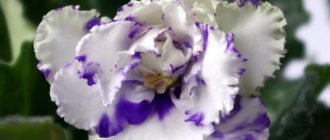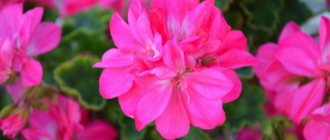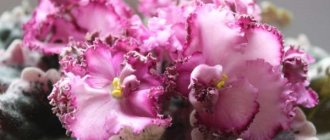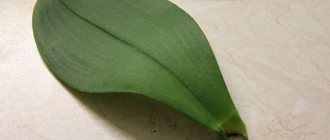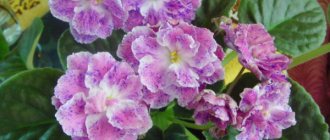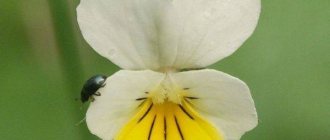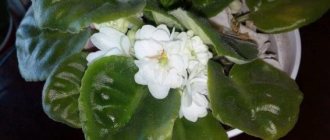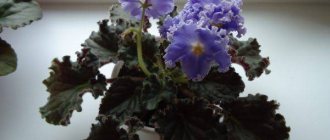Varieties of violets with names and photos are often published in glossy magazines, and large nurseries and online stores publish entire catalogs with detailed descriptions of popular species. These luxurious plants adorn not only the window sills of flower growers and collectors, but also their garden plots. Pansies, which form buds in early spring, when the snow cover has not yet melted in shaded areas, are also representatives of the extensive Violet family. But Saintpaulias, or Uzambara violets, belong to the genus of herbaceous plants of the Gesneriaceae family. Although they are not closely related in terms of classification, it is generally accepted that they are also considered house violets.
Homemade violets and Saintpaulias differ in the shape of the flowers, the structure of the petals, color, presence of inclusions and edgings
Industrial varieties of violets
Industrial violets are the most popular varieties in the world because of their qualities.
They are grown in special nurseries using special technologies for sale to hobbyists and for decorating interiors during celebrations.
In European countries, these plants are used as disposable bouquets, and after use they are simply thrown away.
The positive qualities of industrial varieties include:
- resistance to extreme temperatures;
- undemanding to watering;
- fast growth;
- straight and strong peduncles;
- rich color and long flowering period;
- rosette symmetry;
- simultaneous flowering of a large number of flowers (the so-called swaying);
- good portability;
- loyal attitude to education.
Industrial violets are easy to care for.
These Saintpaulias have regular, slightly rounded leaves with a slight edge. The leaf color is predominantly green.
The flowers of industrial Saintpaulias are small in size and simple in shape, but there are also wavy flowers. Among industrial violets there are no large, double, variegated flowers with frills.
The colors of industrial Saintpaulias are limited to white, pink, blue and two-tone contrasting chimera.
No one will know about the authorship of these varieties or their names. In fact, each variety has its own author and name; it is not important when grown on an industrial scale.
Note! These violets are sold in pots filled with peat. The pot size is much larger than the plant needs. Abundant fertilization and treatment with hormones lead to long, abundant and bright flowering. After the flowering period has passed, it is very difficult to get the same effect from the plant.
Violets from Leroy in our house. Yes or no???
Show description Hello, Elena Buravtsova is with you on the Life of Flowers channel! Today we have a discussion!!! Supermarket Violet Theme! The attitude towards them is contradictory... I invite you to watch and join the discussion in the comments! ,,,,,,,,,,,,,,. “Industrial grade violets!”: https://www.youtube.com/playlist?list=PLJwPzMdr9G2wEBw6Y-UF0ISg9tULimsjI. ,,,,,,,,,,,,,,,. “Kids are fast at any time of the year!”: https://www.youtube.com/playlist?list=PLJwPzMdr9G2yMYnkOnfkg22cXy-4we08T. ,,,,,,,,,,,,,,,. #lifeofflowers #violets
Video taken from the channel: Elena Buravtsova Life of Flowers
Features of cultivation and reproduction
To plant, the leaf is lightly cut and air dried, then planted in the ground. For rapid and abundant formation of roots and leaves, a lean mixture is preferable: peat and sand in a 1:1 ratio. Small shoots feed on the mother leaf.
After 4-6 weeks, when young shoots are formed, they need to be transplanted into individual containers. The earth mixture should contain an increased amount of components in a 1: 1: 1 ratio:
- peat;
- coarse and clean sand;
- turf land.
Each sprout should have its own pot. Ideally, plants should not touch each other's leaves to avoid disease. If there is little space on the windowsill, Saintpaulia can form a rectangular rosette.
For further successful development and flowering, the young plant needs diffuse lighting, regular feeding and moist air.
Carefully! Violet does not like waterlogging of the soil and categorically does not tolerate water getting on the leaves.
Maintenance and care
Swan Lake violet does not require any special conditions for cultivation.
The variety is easy to care for, and even a novice gardener can cope with its cultivation. For proper development and abundant flowering, the variety will require standard conditions:
Intense lighting without direct sunlight hitting the leaves. It is preferable to place the violet on windows facing east or west. To prevent the leaves from being exposed to the burning rays of the sun, therefore, when installed on southern, southwestern or southeastern windows, the plant must be shaded.
The air temperature is not lower than 18 and not higher than 25 degrees. The variety does not respond to temperature changes, but with a critical drop to 11-12 degrees, the process of root rotting may begin.
Air humidity is 50-65%. High humidity leads to the development of fungal diseases, too dry – drying out of the foliage. The problem of high humidity can be solved by ventilating the room
It is only important to make sure that the plant is not in a draft. Dry air is moistened by placing open containers of water next to the violet.
Regular watering
The soil is moderately moistened twice a week. For irrigation use soft, warm water.
Fertilizing with organic and mineral fertilizers. Organic matter is used during the period of rosette formation, mineral mixtures (phosphorus-potassium) - during flowering. Fertilizer should not be applied if the plant is affected by diseases or pests, or if the air temperature is higher or lower than the recommended values. The first portion of fertilizers is applied to the soil 1.5-2 months after transplanting the plant, not earlier.
The Swan Lake violet is contraindicated in high air humidity.
Dutch selection
In a flower shop, all violets are distinguished by their bright and long-lasting flowering, symmetrical rosette, and resistance to conditions and diseases. These Saintpaulias are grown industrially in greenhouses using the latest technology.
Dutch varieties of Saintpaulia are often not even listed, since special workshops are constantly inventing new varieties. We're not even talking about fatherhood.
Violets of Dutch selection are widely represented in flower shops.
They contain so many different chemical fertilizers and growth hormones that it is almost impossible to achieve such flowering from them. For this reason, commercial varieties are called disposable decks.
A feature of the European mentality is the consumer’s attitude towards these plants. Saintpaulias are grown as disposable bouquets that are thrown away after flowering. This is what manufacturers are guided by.
Dutch technical violet propagates well by cuttings, but the value of these plants is not very high. Among collectors, only original varieties with good distinctive qualities are required.
But for the beginning hobbyist, Dutch varieties are attractive in price, unpretentious and bloom brightly.
Pests and diseases to which green violets are susceptible.
Any indoor plant sooner or later faces the problem of disease and pests. Even with proper care. But the green violet is a particularly fragile, defenseless flower that has no natural immunity to this kind of problem. Therefore, only proper care and proper cultivation, preventive work with plant treatment, can protect your beauties on the windowsill. Moreover, most violet diseases are practically incurable and the bushes have to be destroyed after a large-scale infection. Below we will look at the most common diseases and pests for Saintpaulia.
- Late blight - the manifestation of the disease occurs as a result of a violation of the moisture regime of both the soil and the humidity in the room. To prevent the development of sores, ventilate the room more often, and water strictly according to the system and with the correct actions, only into the pan.
- Powdery mildew is manifested by the formation of spots on the leaves, white spots. As the disease progresses, the size of the spots increases. What causes the sore to appear? Violation of temperature conditions, sudden changes. Well, and increased soil moisture. Solve the problem immediately.
-Grey mold manifests itself as a result of increased moisture or decreased temperature, which continues for a certain period of time. A little about pests. Spider mites and aphids are considered the most active and popular for indoor violets. They are the most dangerous, they not only feed on the sap of the plant, which leads to weakening of the violet, but are also the causative agents of diseases dangerous to the flower. The fight against parasites is carried out using traditional medicine, especially during prevention. For larger distribution, it is necessary to use more effective drugs; they can be purchased at any flower shop.
Bottom line.
As we finish this article, let’s sum it up: growing green violets is an interesting and entertaining activity, especially when you start admiring your work. However, this is a labor-intensive process, given the capriciousness of the plant and its fastidiousness in care. Only very patient growers get 100% results
Attention, compliance with all rules, care. Only then does the plant reciprocate your feelings
Top 10 most popular industrial varieties
Raphsody Cora
it has bright white petals with a distinct large indigo dot in the center of each petal. Each petal is wavy at the edges. The leaves are jagged, fluffy, dark green in color with the obligatory shine.
This variety is affected by temperature. During the hot season, blue color predominates and becomes very intense. During the cold period, white color predominates.
Ever Precious
It has white flowers with a bright purple or lilac border with a light green wavy frill around the edge of the flower. The leaves are light in color and have jagged edges.
The variety forms a standard rosette very well.
Rita
Despite the simple semi-double flowers, this variety attracts at first sight with its bright color. On white pansies, a crimson spot creates a bright contrast. This variety belongs to mini or small standards.
The leaves are simple, green. Flowering nods, and has been for a long time. Each short stem has no more than 3 buds.
Ellen
It has an unusual bright pink color with an orange tint. The pansy-shaped flowers have a slight ruffle around the edge. A long flowering period while maintaining bright colors makes this variety attractive.
The leaves are toothed and have a red underside. Standard size.
Ever Rejoice
It attracts lovers with its beautiful salmon color. The flowers are simple, wavy, have a light green border, which disappears when fully opened.
The variety forms a small compact rosette with shiny wavy foliage. It is distinguished by frequent, long-lasting and repeated flowering.
Manitoba
Features a large head of blue flowers with a small spot of a darker shade in the center. The flower shape is pansy. The leaves are rounded, pointed, the underside is red. Peduncles are straight, at least 7 buds.
Attracts with repeated flowering every 2 months and unpretentiousness.
My Love
One of the most popular varieties. The flower is shaped like a star. The color is white with a large contrasting fuchsia spot in the center. The rosette is small, neat, the leaves are simple, dark. Peduncles are straight and strong.
It is distinguished by abundant flowering and swaying.
Mississippi
It attracts with snow-white flowers with soft pink edges. The shape of the flower is pansy, with ruffles along the edge. The leaves are dark, toothed, and form a neat rosette.
By planting the stem of this variety, you can get a plant of chimeric color. This variety belongs to the standard genus.
Glacier
It has white flowers with blue strokes of an original “aspen” shape. Very abundant flowering increases the attractiveness of this variety.
A rosette of even and ideal shape forms a beautiful bright cap of white flowers with a blue tint.
IsaBelle
It blooms with real bells of pale pink color. This variety can be classified as semi-standard: the rosette size does not exceed 20 cm. Small flowers cover the bush with a large dense cap. Peduncles grow from all possible axils; the flowering period is very long.
The AnnaBelle variety is absolutely similar, except for the blue color of the bells.
Violets of Optimara
What it is?
Optimara is one of the world's largest companies growing Uzambara violets and has been around for about a hundred years.
In the early 30s of the last century, Hermann Holtkamp, the owner of a greenhouse in which various plants were grown, decided that the African violet was a nice plant with a great future.
He encouraged businesses to develop new varieties and 20 years later introduced the world's first commercial variety, St. Martin.
The company began to actively develop in this direction and very soon began to specialize only in Saintpaulia. In 1977, the Optimara brand appeared.
Today the company has branches in many countries around the world. During its existence, hundreds of varieties have been bred. The main criterion by which varieties are selected is simplicity and ease of plant care.
A wide range and mass production have allowed Optimara to take a leading position in the world market.
Production and laboratory level for the selection of Saintpaulias
The natural color of violets in nature is dark blue. A biologist, fascinated by this plant, in 1898 managed to develop a variety with purple-red flowers. Over the course of many decades, scientists have developed various varieties that differ in the size, shape and color of the buds.
Optimara continues to actively develop this sector. New types of Saintpaulia are created and grown industrially in laboratories and using the most modern equipment.
Hundreds of new varieties are emerging as a result of industrial breeding.
In America, Optimara monopolized the Saintpaulia market. In addition, this company has branches in Asia, on the African continent. Every year the company not only releases more than one hundred million copies onto the market, but also delights consumers with new varieties.
Good to know! On the company's website there is a photo and name of the varieties, as well as the names of the breeders who are the authors. But Optimara focuses on constantly updating varieties. For this reason, many varietal varieties do not have a name, but only a number.
Varietal characteristics
Despite the wide variety of shapes, sizes and colors, optimar violets have common characteristics by which they can be combined into a single group:
- very fast cutting growth;
- disease resistance;
- early, abundant and long flowering;
- small symmetrical sockets;
- simultaneous opening of buds;
- bright colors of flowers that retain their saturation for a long time;
- good portability;
- short life expectancy.
The Optimara catalog of violets is extensive and is updated with new varieties every year. However, the company is not only engaged in the development of individual varieties.
There are varietal subgroups. Most famous:
- World traveler - Large rosette plants. Typically, varieties of this subgroup have a second name: the name of the city;
- Victorian charm: varied leaf shapes;
- Artist's palette - they are distinguished by large flower sizes and polychrome coloring.
Advantages and disadvantages
If a varietal violet needs to be constantly shaken, flower stalks tied up, sheltered from the sun, and as a result two or three flowers appear that tend to fade, the industrial violet Optimara will quickly form a rosette and bloom profusely.
These plants are surprisingly hardy and hardy, and have little maintenance requirements. They bloom with a large cap above a rosette and bloom brightly and harmoniously.
The show variety Saintpaulia is very difficult to reproduce. You can buy a beautiful new variety, take a cutting, grow a new plant and discover that it has very little in common with the mother bush. All the beauty has disappeared somewhere, there is no form, no dimension, and sometimes the color is completely different.
There are no such problems with optimara violets. All cuttings retain their maternal characteristics. The varieties are resistant to change, which is a big plus in the eyes of amateur gardeners.
Optima violets are easily propagated by cuttings.
But with all the advantages, it is worth considering some of the disadvantages of these Saintpaulias. Firstly, Optimara varieties have been bred for decades for the purpose of one-time flowering in accordance with the needs of the market.
It is very difficult for a beginner to get the plant to bloom again. It is possible, but this requires the necessary knowledge and skills. Plus, the strains really don't last long.
With proper care, you can force a violet to bloom again, but it is much easier to separate the stem immediately after purchase and grow a new specimen.
Possible problems in growing Le violets
Violet does not often suffer from diseases and pests, and with proper care this problem can be avoided altogether.
Diseases
Diseases include powdery mildew and leaf spot. Due to powdery mildew, violet leaves become covered with a white coating, and when spotted, brown spots appear. Dew can be cured by washing the flower with soapy water in the shower, and spotting can be treated with fungicides.
Pests
Among the pests that most trouble Saintpaulia are thrips and aphids. Thrips can be transferred from outdoor trees when ventilating a room. They are destroyed with insecticides Akarin or Dantop. Aphids are located on the back of the leaves and are treated by treating them with tobacco infusion or soap solution.
Other problems
Sometimes there may be problems with drying and falling leaves, as well as lack of flowering. At the same time, it is necessary to reconsider existing care measures.
Le violets are beautiful, and every year their varietal number increases, thanks to the work of Elena Lebetskaya. Bright flowers look beautiful in the interior and do not require complex care.
Are industrial Saintpaulias disposable plants?
Industrial violets are planted in large containers and heavily aromatized with growth stimulants. In such conditions, the plant reaches maturity very quickly and blooms profusely.
A long flowering period, stressful situations associated with transportation and storage in warehouses lead to depletion of the plant.
In America and Europe, Saintpaulias are considered “bouquet” plants. They are bought as a one-time bouquet, and not as a houseplant.
Important! The producer's goal is a successful sale, and the consumer attitude of buyers does not anticipate re-blooming.
